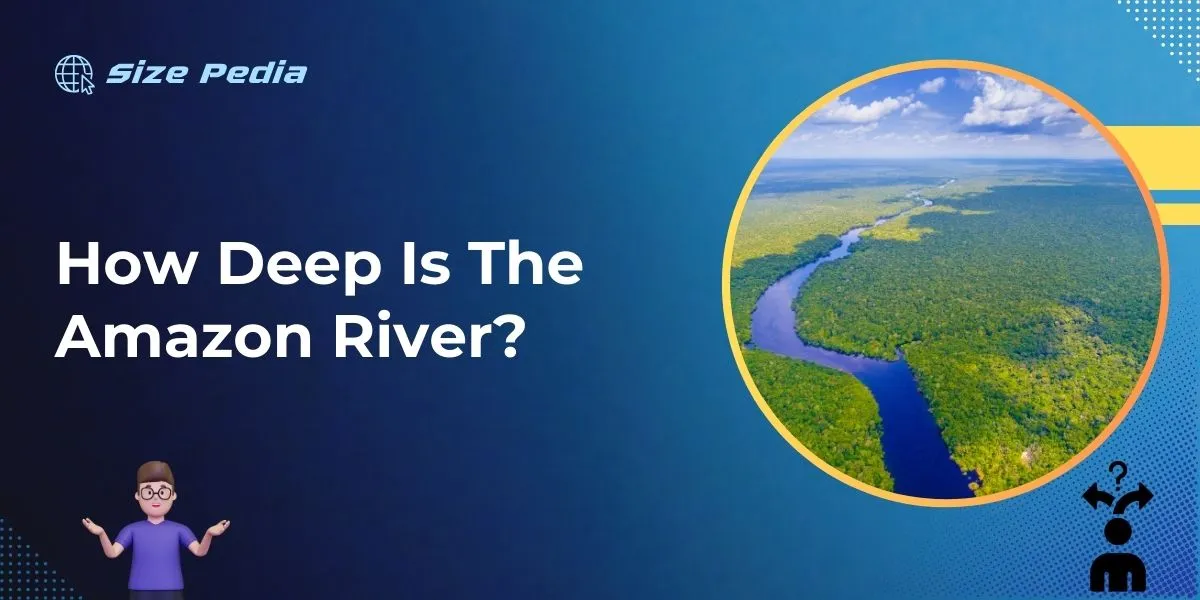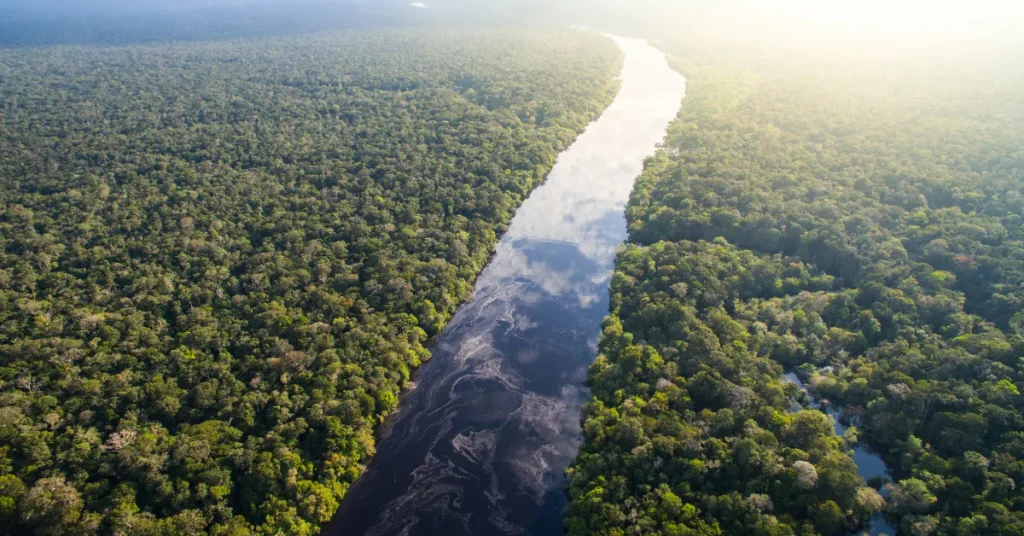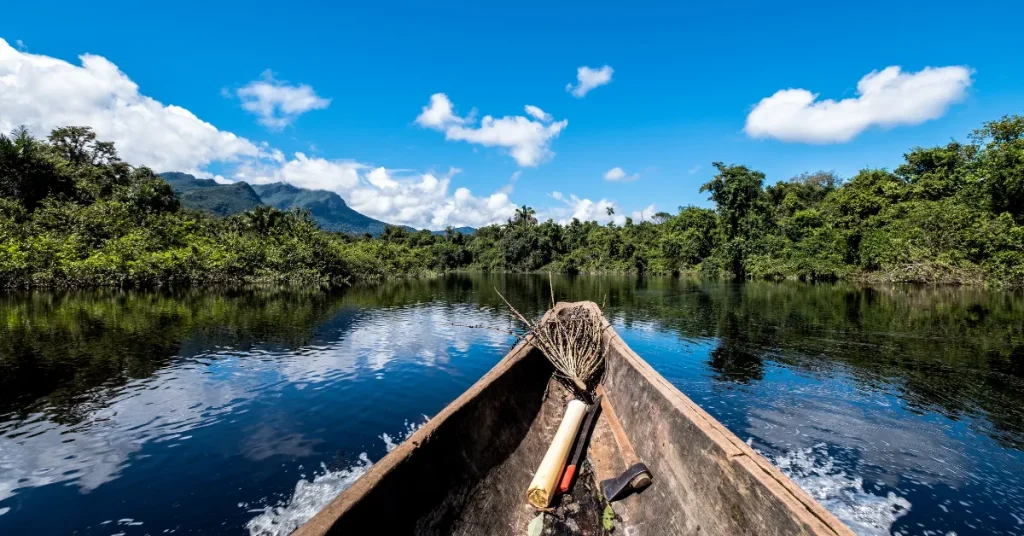The Amazon River reaches a maximum depth of approximately 100 meters (about 330 feet). The average depth is around 20 to 50 meters (65 to 150 feet).
Exploring the vastness of the Amazon Rainforest, the river at its heart stands as one of the most impressive natural wonders on the planet. Stretching across South America, it carves a path through dense jungles and supports a myriad of ecosystems.
The Amazon River, often referred to as the lifeblood of the forest, boasts a rich biodiversity unparalleled anywhere else in the world. As the second-longest river globally, it plays a critical role in global water cycles and climate regulation.
Travelers and scientists alike are drawn to its waters, seeking to uncover the mysteries of its depths and the secrets of the surrounding rainforest.

The Enigma Of The Amazon River
The Amazon River winds its way through the heart of South America. It’s a lifeline for the jungle. It holds secrets under its murky waters. People say it’s the second longest river. But this is just one part of its story.
Myths And Realities
Myths have created a mysterious halo around the Amazon. Some tales tell of a city of gold. Others speak of monstrous creatures in its depths.
These stories capture our imagination. Yet, the true Amazon is just as fascinating. Scientists keep discovering new life forms here. The Amazon isn’t just a river. It’s a vast, flowing network of waterways.
Significance In World Geography
In world geography, the Amazon stands out. It pours more water into the ocean than any other river. It’s a powerhouse of biodiversity. This river nurtures the rainforest. Without it, countless plants and animals wouldn’t survive.
- Broadest river in the world
- Over 7,000 species of fish
- Oxygen supplier for Earth
Measuring The Depths
The Amazon River unfurls its serpentine body across the South American continent. Its depths harbor a world less known, teeming beneath the water’s surface.
Measuring these depths uncovers the river’s secrets and showcases its might. Let’s delve into the deep with modern methods and face the challenges head-on.
Tools And Technology
Exploring the Amazon’s depths necessitates advanced tools:
- Echo Sounders – These devices send sound pulses into the river. Pulses bounce back, revealing depth.
- Sonar Technology – Similar to echo sounders but more refined. Offers detailed underwater landscapes.
- Satellite Imagery – Helps estimate river depth from space using special sensors.
- Submersibles – Manned or unmanned vessels dive to capture direct measurements.
Challenges In Depth Measurement
Measuring the Amazon’s depths presents unique challenges:
- Changing Water Levels – Seasonal rains elevate water levels, complicating consistent measurements.
- Remote Locations – Accessibility is a struggle in the dense Amazonian jungle.
- Variable Riverbed – Sand banks and underwater plants shift, changing depth profiles.
- Turbulent Waters – Strong currents disrupt measurement equipment.
The Dynamic Nature Of River Depths

The Dynamic Nature of River Depths captures the ever-evolving story of the Amazon River. Underlying this immense water body’s surface is a pulsating rhythm, dictating its depth and shaping its ecosystem.
The Amazon’s depths are not static; they breathe with seasonal pulses and react to the broader impacts of climate change.
Seasonal Variations
The Amazon River is a living entity, changing with the seasons. Rainy and dry seasons play a vital role in this fluctuation.
During the wet months, waters rise, often reaching up to 50 feet deeper. Conversely, in the dry season, water levels drop, revealing the river’s sandy banks. Let’s break down these shifts:
- High Water Season (December to May): The river swells as snow melts and rainfall increases upstream.
- Low Water Season (June to November): Water retreats, and islands emerge, reshaping the river’s navigation routes.
Impact Of Climate Change
Climate change alters precipitation patterns and extreme weather events, affecting the Amazon’s depths. Rising global temperatures can lead to unpredictable water levels, disrupting local wildlife and communities. Key points include:
| Climate Change Effect | Consequence on Depth |
| Inconsistent Rainfall | Varying river levels, more frequent extreme conditions |
| Increased Evaporation | Lower water levels during hotter months |
The Amazon’s behavior today might not reflect its reality tomorrow. What remains certain is the need to understand and protect this vital resource, ensuring it endures for generations to come.
Comparative Depths: Amazon Versus Other Great Rivers
When we think about grand rivers, the Amazon often springs to mind. It’s famous for its length and the life it supports. Yet, its depth is a marvel too. Comparing the Amazon’s depths with other great rivers reveals surprises under the surface.
Nile And Congo
The Nile river, at about 30 feet deep, is a giant snaking through Egypt. Despite its fame, it’s not that deep. The Congo, on the other hand, plunges to over 720 feet.
The Amazon, in its deepest point, reaches around 300 feet. It matches neither the shallowness of the Nile nor the depths of the Congo.
| River | Maximum Depth |
| Amazon | Approx. 300 feet |
| Nile | Approx. 30 feet |
| Congo | Over 720 feet |
Yangtze And Mississippi
The Yangtze, Asia’s longest river, boasts a depth of around 200 feet in certain areas. The Amazon, which is even longer, often surprises with tranquil shallows and great depths alike.
Mississippi’s deepest part is only about 200 feet, making it similar to the Yangtze but less deep than the Amazon.
- Yangtze: 200 feet deep in places
- Amazon: Around 300 feet at its deepest
- Mississippi: Depths up to 200 feet
In summary, the Amazon sits between extremes. It’s more profound than some, yet not as deep as others. These rivers, every one, hold their unique secrets beneath the surface.
The Mysteries Beneath The Surface
The Amazon River, a marvel that snakes through the heart of the rainforest, holds countless secrets within its murky depths. It’s not only the world’s largest river by volume but also a treasure trove of mystery and exploration.
Miles beneath the surface, the Amazon fosters an inaccessible world, veiled from human eyes. Embrace the journey as we dive into the enigmatic realms lying beneath the river’s surface.
Biodiversity In The Depths
The Amazon’s underwater world teems with life. It’s home to a vast array of creatures, some of which scientists have yet to unveil.
- Pink river dolphins grace the waters, enchanting observers.
- Piranhas roam with razor-sharp teeth, an illustration of nature’s raw beauty.
- Electric eels emit charges, adding shock to the aquatic dance of survival.
Explorers uncover new species within these realms, rendering the Amazon a living, breathing scientific marvel.
Unexplored And Unmapped Regions
Bold adventurers and scientists alike yearn to chart the Amazon’s concealed corners.
Areas untouched by light, where the river’s true depth remains a question, beckon for discovery.
| Region | Description |
| Unknown Tributaries | Hidden offshoots of the river, potentially harboring unique ecosystems. |
| Submerged Forests | Aquatic forests that provide shelter and nutrients to diverse marine life. |
| Uncharted Depths | The deepest parts of the Amazon, where its darkest secrets lie. |
Many areas remain unexplored due to their remote location and challenging conditions.
These mysterious waters inspire curiosity and beg for future explorers to reveal their untold stories.
Human Interactions With The Amazon River’s Depths

The Amazon River’s depths hold secrets and challenges for humans. Its murky waters and hidden currents define the life along its banks. Here we explore how people engage with this mighty river.
Navigation And Commerce
The Amazon River, vital for transport, breathes life into local economies. Because it is so deep, big ships can sail its lengths. This makes trade and travel easier for many people.
- Riverboats serve as the main transport vessels, carrying goods and passengers.
- Port cities like Manaus and Belém thrive on river-based trade.
- Fishing boats navigate shallower parts, providing food and employment.
Conservation Efforts
The Amazon’s depths are also at the forefront of conservation. As threats to the river rise, so do the efforts to protect it.
- Organizations work to preserve water quality and aquatic habitats.
- Education programs teach locals about sustainable fishing methods.
- Studies on the river’s biodiversity guide conservation policies.
FAQs About How Deep Is The Amazon River
What Is The Maximum Depth Of The Amazon River?
The Amazon River reaches its maximum depth at approximately 100 meters, or about 330 feet. This depth varies depending on the season and the amount of rainfall.
How Does The Amazon River Depth Affect Biodiversity?
The varying depths of the Amazon River create diverse habitats. These support a wide range of aquatic and terrestrial species, contributing to the region’s vast biodiversity.
Where Is The Amazon River Deepest Point?
The deepest point of the Amazon River is in Brazil, near the city of Manaus. This section, which is also known as the Amazon Basin, is prone to significant depth changes throughout the year.
Does The Amazon River Depth Fluctuate Annually?
Yes, the depth of the Amazon River fluctuates annually. During the wet season, it can rise over 9 meters (30 feet) higher than during the dry season, significantly altering its depth.
Conclusion
Exploring the depths of the Amazon River reveals a world teeming with life and natural wonders.
We’ve journeyed through the varying depths, uncovering its secrets from shallow tributaries to deeper channels. For adventurers and scientists alike, the river remains a source of endless fascination.
Remember, the Amazon’s depth is more than a number—it’s a living testament to Earth’s dynamic nature.
Resources:
1. https://earthobservatory.nasa.gov/images/145649/mapping-the-amazon
